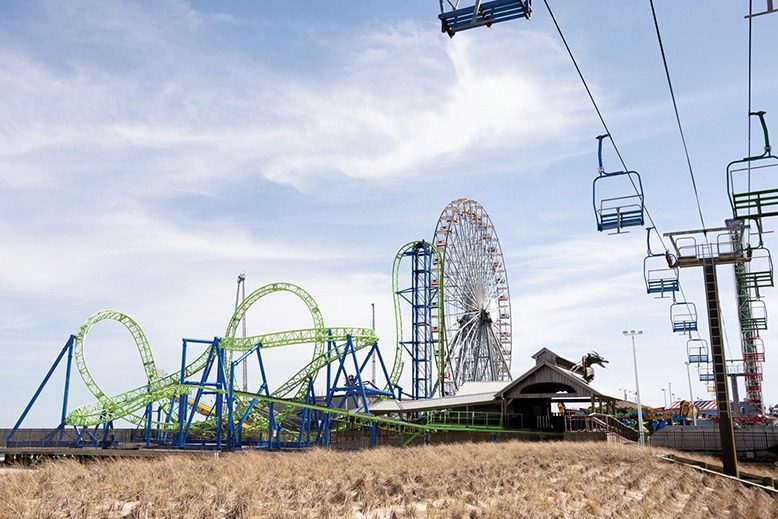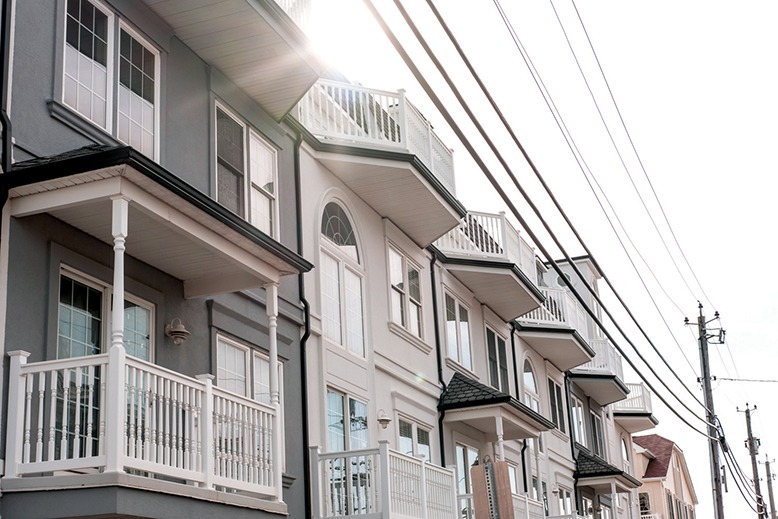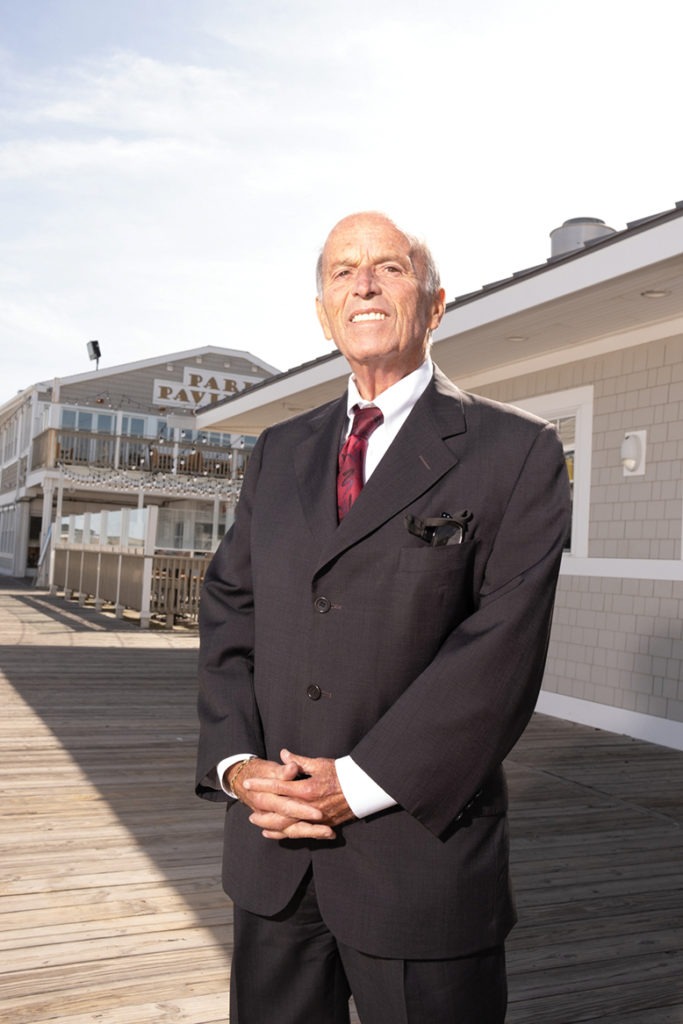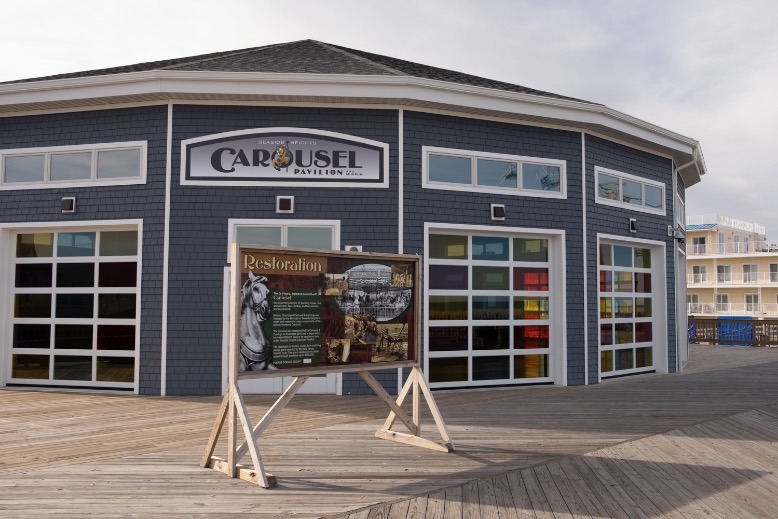
The mayor’s office in Seaside Heights sits just a block away from a boardwalk whose calliope rhythms and pulsing lights have colored the summer dreams of generations of New Jerseyans. But when Tony Vaz—who has served in local government for half the 55 years he has lived here, the last seven as mayor—heads out to show the latest and largest changes in town, he leaves the 13-story Ferris wheel that towers over it all in his rear-view mirror and heads instead in the opposite direction.
“Any street you go down, you’re going to find something new,” he says, pointing out new houses and condos as he returns waves from other drivers and pedestrians who recognize him in this small town where the year-round population of 3,000 explodes to more than 60,000 on a summer weekend. “New…new…all new.”
Seaside Heights is just four blocks wide from ocean to bay, 16 blocks long from north to south, and, for most of its life since its founding in 1913, it was a beach town of bungalows, motels and rooming houses that emptied out by noon on Labor Day each year.
In more recent decades, it was also a place where so many people poured out of the nightclubs at closing time that the police had to shut down the street to let them pass. It was a place where chest-puffing young men brayed, “What did you just say to me?” before taking a swing; where young women staggering on stiletto heels wailed, “But he said he loved me!” through mascara tears; where you might be awakened at 4 am by people pounding on your motel room door because too much vodka made them forget which room was actually theirs. It was the place where Snooki got punched on MTV’s Jersey Shore.

MTV’s “Jersey Shore” brought its antics to Seaside Heights. Pictured are Season 1 cast members (back row, from left) Angelina Pivarnick, Jenni “JWoww” Farley, Nicole “Snooki” Polizzi, Mike “The Situation” Sorrentino, (front row, from left) Vinny Guadagnino, DJ Pauly D, Ronnie Ortiz-Magro and Sammi “Sweetheart” Giancola. Photo courtesy of MTV Networks/Photofest
“This is coming down, and it’s going to be 14 townhouses,” Vaz says, passing one defunct motel slated for demolition, and then, when passing another, “This is being torn down; condos are going here.”
And on Boulevard, the artery one block in from the boardwalk, where the biggest nightclubs once stood and where the town’s biggest plans are now gestating, he points to a block-long empty lot that, to his great delight, was bulldozed clear last fall. “That was the Bamboo Bar,” he says, known to TV viewers around the world as the sprawling nightclub where the Jersey Shore cast drank, danced and brawled.
Vaz was 20 when he moved to Seaside Heights from Paterson, a newlywed studying to become a teacher, and he and his wife had their three children while they lived in a house right behind the Bamboo. “It caused us no problems then; it was a different kind of clientele,” he says. “Now it’s going to be 48 residential units, with retail on the ground floor.”

Residential development is at the forefront of the new vision for Seaside Heights. Photo by Justin Borucki
It was in 2012 that Hurricane Sandy arrived in Seaside Heights and Snooki and company departed—the two storms that shaped what happened here over the subsequent decade. Jersey Shore made Seaside Heights a household name far beyond New Jersey; Sandy wrecked more than half the homes and businesses. As the town commenced rebuilding, that combination of a high profile and a clean slate made it rethink what it should be. Add to that the frantic real estate market of the last two years, the pandemic exodus from the cities, and the inescapable geographical fact that land along the Jersey Shore is finite, and you get a town where nightclubs make way for condos, and condos are sold before a shovel even hits the ground.
“We’re the last frontier,” Vaz says.
***
“It happened right there, right at the corner of that bar; that’s where Snooki got punched,” Mike Carbone says, pointing to a bar on the first floor of the Beachcomber Bar & Grill, the boardwalk business he has long owned. “I was here when it happened.”
He has also been here for everything else that has happened in Seaside Heights since 1965, when he was 10 years old and selling the Daily News outside the Carousel Arcade, the business his family eventually owned, just across the boardwalk from where his own business is now. During Sandy, he watched from his upstairs apartment as the ocean rose and washed through his building, and then, not even a year later, he watched as it was damaged in the fire that consumed Funtown Pier and left the town wondering which biblical plague might strike next. He is also a longtime borough councilman, and he has watched the effects of the decisions the town’s government has made in recent years.
“The town has been changing,” says Carbone, who books plenty of bands into the Beachcomber, but who also started Friday night bingo there several years ago. “It’s not like the way people always think, that Seaside has a bad name. We’ve got strollers on the boardwalk and baby carriages.”
Vaz uses two phrases extensively to describe what he wants to eliminate in Seaside Heights (the bar atmosphere) and what he wants the town to be (family-oriented): “Jersey Shore tapped into something that was already in existence, and they just made it worse. That idea of, just go to Seaside and do what you want to do—those days are over.”
Bamboo and Karma, the other big nightclub on Boulevard, closed several years ago, and the town has tried to keep anything like them from returning. Teen nights at bars (18 to enter, 21 to drink) are banned, and the quieter north end of town was rezoned in a way that restricts liquor licenses to sit-down restaurants that serve more than just pizza slices.
Over the last several years, the town has also cracked down on the places where people spend the night after last call and where the police are too frequent a presence. “It’s not just the motels,” says Christopher Vaz, a lawyer who now serves as the borough administrator (he was hired before his father became mayor). “The problem over time grew from the motels into other investors that own apartments and houses.”
Motels that hand a key to some high school kids during prom season and then look the other way as cases of beer are hauled inside; landlords who rent a house meant to sleep six to a group that plans to sleep 26—those are the targets of the 2018 Animal House ordinance, which gave local officials more power to take harsh measures against problem properties in town. Another recent ordinance bans renting to anyone under 18.
“You’re never going to stop proms, you’re never going to stop underage drinking, but with controls, you’ll minimize very serious events,” Mayor Vaz says. “We’re recognizing the problems in the past, and we’re saying, ‘Hey, no more, it’s ended now. Straighten up or we’re going to go after you.’”
A closer eye on those properties has meant more code-enforcement citations—up 40 percent over the last 18 months, according to Ken Roberts, the town’s code-enforcement and zoning officer. With the big clubs gone and the rentals tightened, annual arrests are down to about 700 from a peak of 2,600, according to the Seaside Heights police chief, Thomas Boyd.

Seaside Heights Mayor Tony Vaz is leading the charge for change in Seaside Heights. Photo by Justin Borucki
“Seaside was always kind of a honky-tonk town, but the mayor and administrator sat me down and said, ‘Tom, we’ve got to change the image,’ and I’ve got to tell you, I looked at them like they had two heads, because it’s been going on for so many years,” says Boyd, a third-generation Seaside Heights native who has been chief for 20 years. The elementary school is named for his father, the longtime school superintendent. “I always say nothing good happens in a bar after 12 o’clock. Alcohol makes good people do stupid things.”
At the end of last summer, the town took its most aggressive step yet, moving to revoke the mercantile licenses of three motels and six rental properties; the cases are still in litigation.
But by the start of this summer, seven of the 42 motels in Seaside Heights will be gone, casualties as much of a tighter real estate market as of tighter rules. The Quality Inn was demolished in November to make way for 10 townhouses; eight single-family homes will rise where the Aquarius Arms Motel once stood. The full-block property of the Offshore Motel, one of the three the town moved against, is on the market, listed at $5.8 million.
“I’ve got five condos I sold a little over two years ago in the high threes, and I just closed on one of them the other day for [$605,000],” says Mike Loundy, owner of Seaside Realty. Before going into real estate full-time he ran Barney’s, the small corner restaurant his grandfather opened in 1932, which remained in his family for 58 years. “People say, ‘Geez, overnight Seaside Heights has really turned into something,’ but it’s been happening since the very moment after Sandy. Seaside Heights had the vision right after Sandy to take that opportunity to really remake the look of the town, and that’s pretty much what we’re seeing now.”
The more that owners pay for properties, the town reasons, the more watchful they will be when renting them. “They’re not going to spend 6, 7, $800,000 and then rent to people that are going to destroy their property,” Mayor Vaz says.

“It’s not like the way people always think, that Seaside has a bad name,” says Mike Carbone, longtime owner of the Beachcomber Bar & Grill. “We’ve got strollers on the boardwalk and baby carriages.” Photo by Justin Borucki
Older, cheaper properties in Seaside Heights were often occupied by renters assisted by Section 8 housing vouchers. “But Section 8 rentals have become less appealing to property owners because the math no longer works,” Loundy says. “They can make more money renting on a weekly basis in the summertime.”
Because Ocean County has no shelter for displaced people, it has relied on the Seaside Heights motels for transitional housing. “It’s always been a hub for utilizing for people in need, and now, losing that hub creates other issues,” says Paul Hulse, the president and CEO of Just Believe, Inc., a nonprofit that runs a warming center for the homeless in Toms River. “We used to have 15 or 20 motels to choose from, but now, you’ve shrunk that down to a small number; now you’re looking at three to five.”
***
Mayor Vaz is up at the north end of the boardwalk now at the Carousel Museum, the airy new pavilion where—by next spring, he expects—the historic 1910 carousel that spun for decades on the Casino Pier and is now in Ohio for restoration will spin again. The building will also display artifacts and images from summers long past. “Family-oriented,” he says once again.

The Carousel Museum will house—hopefully by next spring—the historic 1910 carousel that spun for decades on the Casino Pier. Photo by Justin Borucki
At the south end of the boardwalk is another new building, the Ocean Club, which marked a distinct break from the past when it opened at the end of last summer. “They made it very clear that they didn’t want a nightclub,” says Ben Mabie, whose family has been in the building and real estate business in Ocean County since 1950, about the town’s initial reaction to the project. “If that was the case, we would have saved a lot of money and bought the Bamboo and the liquor license, and just put lipstick on a pig and reopened that, but that was not our intention.”
The project instead is a high-end slice of Monmouth County that has drifted south: an upscale restaurant and wedding venue á la Long Branch; a beach club with a pool and cabanas renting for $22,000 a season, like in Sea Bright. “I don’t know that we would have done this back when the nightclub thing was kind of fading and the town was in a transitional place,” Mabie says
But it’s on Boulevard that the slate is the cleanest and the plans the largest—an avenue Mayor Vaz hopes to see lined with restaurants, residences and shops. One block was cleared last summer of the steel skeleton of a large nightclub project that started before Sandy, then stalled and sat neglected for a decade, like a persistent bad memory. Now, an eight-story building is planned for across the street, with 79 residences, a restaurant and retail storefronts. The plans for the nearby Bamboo lot are for a similar mixture of retail and residences.
“The town had the foresight to see that the Boulevard as it used to be was no longer tenable,” says Rudy Daunno, project broker for what will be called the Lofts at Bamboo. He spent some nights at the club himself, back when he was in his early 20s and renting a bungalow in Seaside Heights for the summer. “They put the redevelopment plan in the works, which made a project like this feasible. This was a way for them to give these big properties new life.”
Circling back toward borough hall, Mayor Vaz passes a building with several new storefronts that are expected to open by summer, one of which has a surprising sign: “The Snooki Shop.”
“Nicole is coming back,” he says, pointedly eschewing the nickname of Nicole “Snooki” Polizzi, who, in her post-Bamboo incarnation, has opened two boutiques already—in Madison, New Jersey, and Beacon, New York—and who is opening her third in the place that is no longer like the place that made her famous. “Nicole knows our vision in Seaside Heights.”
Kevin Coyne, a longtime contributor to New Jersey Monthly, teaches at Columbia Journalism School.
